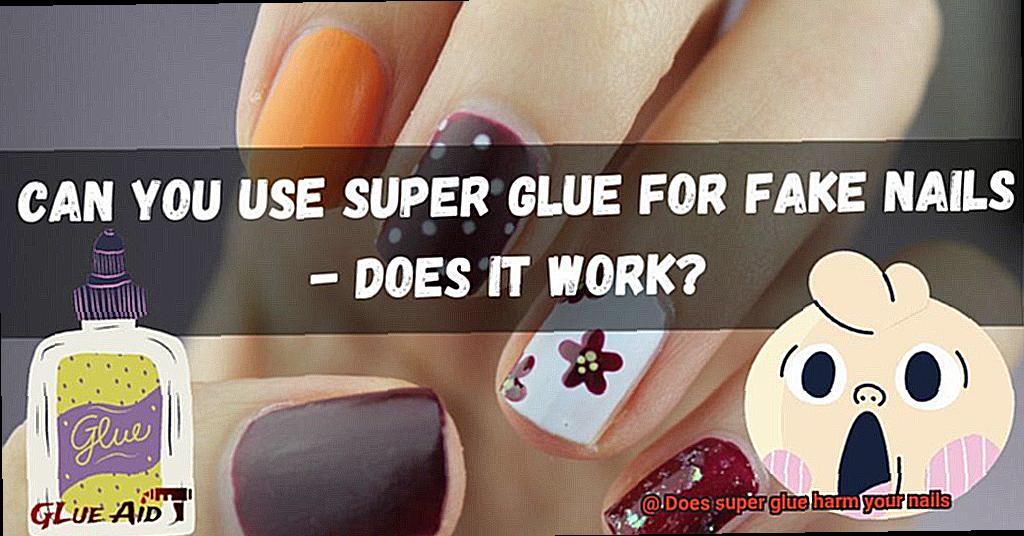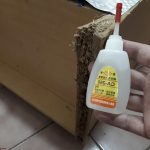Nails are more than just fingertip armor. They’re like tiny canvases for our self-expression, showing off our style, personality, and creativity. But life happens, and sometimes our nails take a hit – chips, breaks, you name it. And that’s where super glue swoops in as the superhero of quick fixes.
Before you go gluing your precious nails back together, let’s talk about the potential risks versus rewards.
In this blog post, we’re diving deep into the world of super glue to separate fact from fiction when it comes to your nail health. We’ll bust those pesky myths and give you all the deets on how to use super glue properly without causing harm. Because hey, we want you armed with knowledge so you can make smart choices when it comes to fixing those beautiful nails of yours.
So, buckle up as we explore the science behind super glue, its possible effects on your nails (spoiler alert: it’s not all bad news), and some handy tips to keep any damage at bay. Get ready to separate truth from tall tales in the wild world of nail repair.
Advantages of Using Super Glue on Nails
Contents
- 1 Advantages of Using Super Glue on Nails
- 2 Disadvantages of Using Super Glue on Nails
- 3 The Chemical Composition of Super Glue and its Effects on Nails
- 4 Potential Health Risks Associated with Using Super Glue on Nails
- 5 How to Safely Use Super Glue on Your Nails
- 6 Alternative Products for Applying to Nails
- 7 Tips for Preventing Damage when Using Super Glue
- 8 How to Remove Excess or Dried-on Super Glue from Nails
- 9 Conclusion
Super glue is a game-changing product when it comes to fixing broken nails or getting creative with nail art. Its quick application, strong bond, versatility, cost-effectiveness, and long-lasting results make it a popular choice among nail enthusiasts. However, responsible usage is essential to protect the health of your nails. In this article, we will explore in detail the advantages of using super glue on nails and provide essential tips for safe usage.
Advantage 1: Quick and Easy Application
Super glue’s convenience lies in its rapid drying time upon contact with the nail. Unlike traditional nail glue that requires multiple coats and lengthy drying periods, super glue provides an instant fix for broken or chipped nails. Say goodbye to waiting around for your nails to dry. With super glue, you can quickly repair any damage and have your nails looking flawless in no time.
Advantage 2: Strong Bond
One of the standout advantages of using super glue on nails is its exceptional bonding strength. When applied correctly, it creates a durable bond between the natural nail and artificial enhancements like acrylic or gel extensions.
This strong bond ensures that your manicure stays intact for a longer period, eliminating the need for frequent touch-ups or worrying about weak nail structures. Feel confident knowing that your nails will remain beautifully intact.
Advantage 3: Versatility
Super glue isn’t just for fixing broken nails; it’s also perfect for unleashing your creativity with decorative elements. Its strong adhesive properties make attaching gems, rhinestones, or other nail art elements a breeze. Whether you want to add a touch of sparkle or experiment with intricate designs, super glue provides the reliability needed to showcase your unique style.
Advantage 4: Cost-Effective
Compared to specialized nail glues, super glue is often more affordable and accessible. You can find it in most households or purchase it at low prices from hardware stores or online retailers. Save money while achieving salon-quality results. Don’t let expensive nail products hinder your creative expression.
Advantage 5: Long-Lasting Results
Super glue forms a long-lasting bond that can withstand everyday activities and exposure to water. This means your manicure will stay intact for an extended period, reducing the need for frequent repairs or touch-ups. Additionally, super glue can even help strengthen weak nails by providing an extra layer of protection. Enjoy beautiful, durable nails that withstand the test of time.
Disadvantages of Using Super Glue on Nails
Super glue, although seemingly convenient for repairing broken or split nails, comes with several disadvantages that should be considered before use.
One major drawback is the difficulty in removing super glue from nails. Unlike nail glue, which can be dissolved or removed with acetone, super glue forms an incredibly strong bond that is challenging to break. This means that if you accidentally apply too much or make a mistake during application, it can be a frustrating ordeal to correct or remove the glue without causing damage to your nails.
Moreover, super glue contains harsh chemicals that can be harmful to your nails and surrounding skin. These chemicals can cause dryness, irritation, and even allergic reactions in some individuals. Continued use of super glue on nails can weaken and damage the nail beds, making them more prone to breakage and other issues.
In addition, super glue interferes with the natural process of nail growth. It forms a rigid layer over the nails, inhibiting their ability to breathe and receive necessary nutrients. As a result, your nails may become weak, brittle, and more susceptible to splitting, peeling, and overall poor health.
Accidental skin bonding is another risk when using super glue on nails. Its fast-drying nature means that it can quickly bond skin together, causing pain and difficulty in separating the glued areas. This can be particularly problematic if it occurs near the delicate nail bed or cuticles, as it may require professional intervention to safely remove the adhesive without causing further damage.

Furthermore, using super glue on nails can give a false sense of security. While it may temporarily fix a broken or split nail, it does not address the underlying issue causing the problem. It’s important to identify and address the root cause of nail damage or weakness rather than relying on a quick fix like super glue.
The Chemical Composition of Super Glue and its Effects on Nails
Well, let’s peel back the layers and delve into the chemical composition of this powerful adhesive, while unraveling its effects on our precious nails.
At its core, super glue, also known as cyanoacrylate adhesive, is a force to be reckoned with. Its star player is cyanoacrylate, a colorless and transparent liquid that miraculously transforms into an unbreakable bond when exposed to moisture. This is why it’s so effective at temporarily fixing broken or split nails.
But here’s the catch – despite its impressive capabilities, super glue can have some not-so-great effects on our nail health. Brace yourselves, because this might come as a surprise. The adhesive has the power to dehydrate our nails, leaving them brittle and weak. Yes, you heard it right. Super glue can sap the moisture from our nails, making them prone to breakage.
Super glue can also cast an unsightly shadow over our nails in the form of discoloration. Our beloved natural nail color can be tainted by a yellow or darkening hue when super glue reacts with the proteins in our nails. Not exactly the look we’re going for, right?
But wait, there’s more. For some unfortunate individuals, super glue can trigger allergic reactions. If you happen to be sensitive or allergic to cyanoacrylate, applying super glue to your nails could result in redness, swelling, itching, or even blisters around your nail area. A sticky situation indeed.
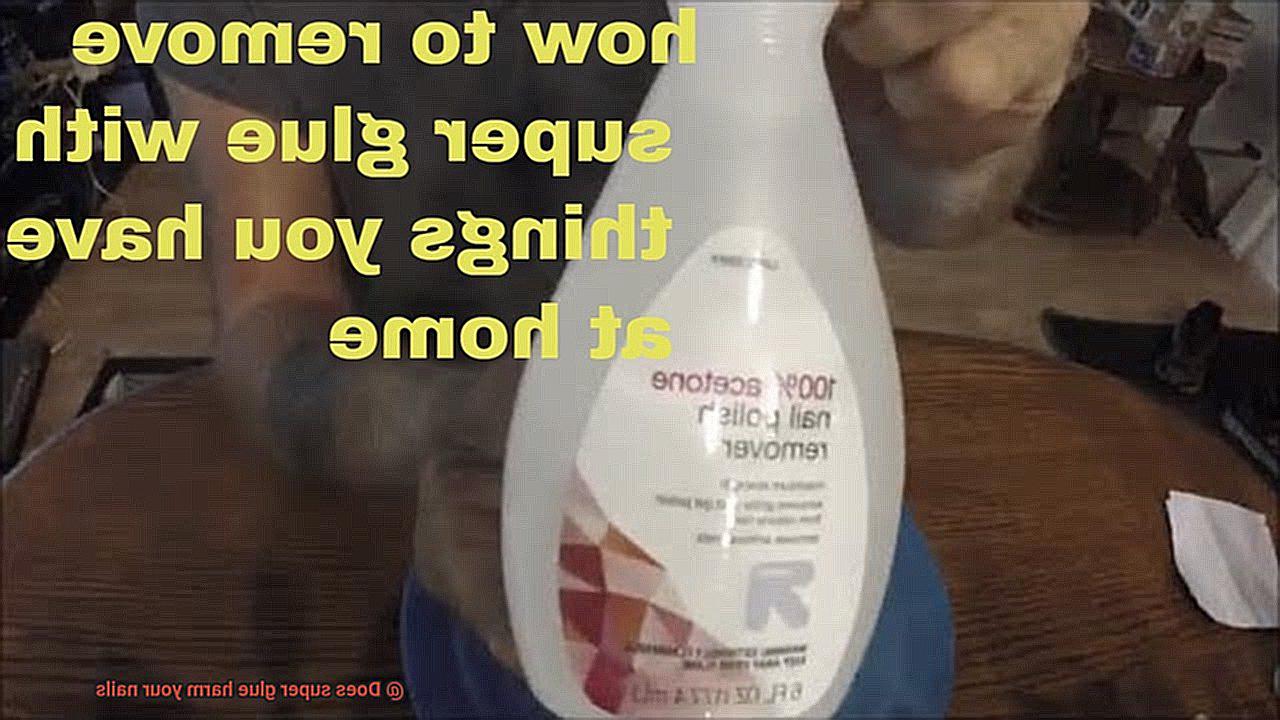
But fear not. There are ways to minimize the potential harm caused by super glue. First and foremost, apply a thin layer of the adhesive and take care to avoid contact with the surrounding skin or cuticles. And when it’s time to bid adieu to that temporary fix, be gentle during the removal process. Soaking your nails in warm soapy water or using an acetone-based nail polish remover can dissolve and remove the adhesive without causing further damage.
It’s important to note that not everyone will experience negative effects from using super glue on their nails. Some lucky individuals possess a higher resistance to the potential side effects. However, if you notice any signs of an allergic reaction or your nails feel drier than a desert, it’s time to bid farewell to super glue and explore nail-friendly alternatives.
Potential Health Risks Associated with Using Super Glue on Nails
In the nail emergency of a broken nail, reaching for the trusty super glue may seem like a quick and convenient solution. However, it’s crucial to be aware of the potential health risks associated with using super glue on your nails.
In this article, we will delve into the nitty-gritty details of how super glue can impact your nail health and discuss the precautions you should take.
Skin Irritation and Allergic Reactions:
Super glue contains chemicals that may not be safe for prolonged contact with your skin and nails. When applied near the delicate nail bed or cuticles, it can cause skin irritation, itching, redness, or even a rash. In some cases, individuals may experience a severe allergic reaction called contact dermatitis, resulting in blistering, swelling, or painful sores around the nail area.
Nail Bed Damage:

Removing super glue can be a tricky task, and if done improperly, it may lead to peeling or tearing of the nail surface. This can weaken your nails and potentially cause further damage. It is crucial to use proper removal techniques and avoid excessive force when detaching glued nails.
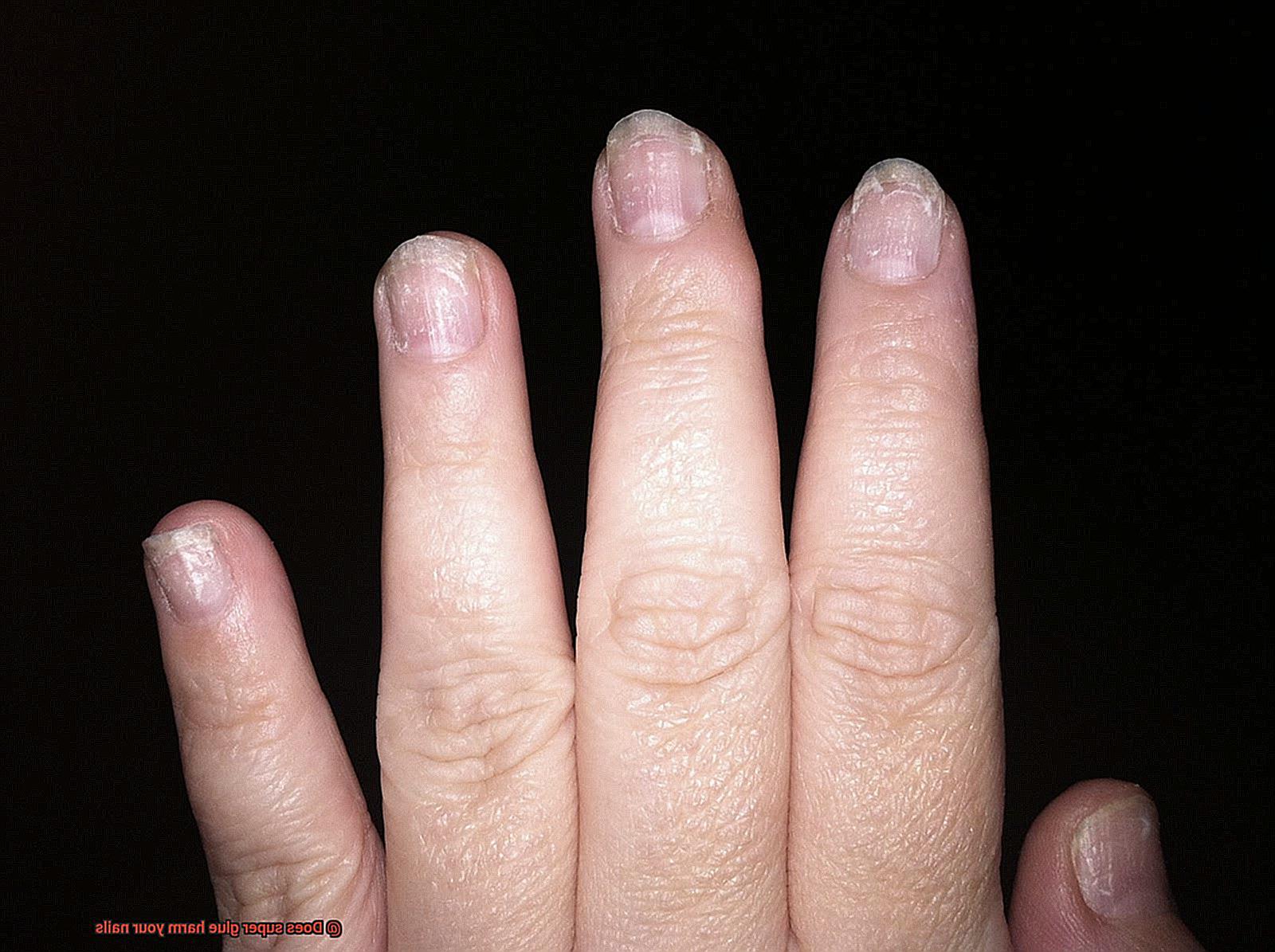
Restricted Blood Circulation:
Applying super glue too close to the cuticles or skin surrounding the nails can restrict proper blood circulation. This restriction can result in pain, discoloration, and in severe cases, even loss of the nail if left untreated. It is important to avoid applying super glue too close to these delicate areas to ensure adequate blood flow.
Inhalation of Fumes:
Super glue emits fumes that can be harmful if inhaled in large quantities. Although the amount of fumes produced during nail application is relatively small, repeated or prolonged exposure to these fumes could potentially have adverse effects on respiratory health. To minimize this risk, it is always advisable to ensure proper ventilation when using super glue.
How to Safely Use Super Glue on Your Nails
Super glue can be a helpful tool when used safely and correctly. In this comprehensive guide, we will show you how to safely use super glue on your nails, ensuring beautiful results without any harm or damage.
Step 1: Preparation is Key
To start, it is crucial to prepare your nails properly. Begin by cleaning them thoroughly with an acetone-based nail polish remover. This will remove any oils or lotions from the surface of your nails, allowing the glue to adhere properly and ensuring a longer-lasting bond.
Step 2: Create a Protective Barrier
To protect your natural nails from any potential damage, apply a thin layer of clear nail polish or a base coat. This acts as a barrier between the super glue and your nails, preventing direct contact and minimizing the risk of harm.
Step 3: Less is More
When it comes to using super glue on your nails, remember that less is more. Apply a small drop or two of super glue directly onto the desired area. It is important to avoid applying too much glue, as excessive buildup can harm your nails and make removal difficult later on.

Step 4: Handle with Care
Super glue is a powerful adhesive that can bond skin together within seconds. To avoid any accidental skin contact, consider wearing disposable gloves while working with super glue. This adds an extra layer of protection and ensures that your skin remains intact.
Step 5: Precise Application
For precise application of the super glue onto your nails, use a thin brush or a toothpick. Gently dab the glue onto the desired area, making sure to avoid getting it on your skin or cuticles. If any excess glue does come into contact with your skin, quickly wipe it away with a cotton swab or tissue.
Step 6: Allow Time to Dry
Once you have applied the super glue, give it ample time to dry completely before engaging in any activities that may put stress on your nails. This will ensure that the glue has fully bonded and minimize the risk of damage.
Step 7: Safe Removal
When it’s time to remove the super glue from your nails, soak them in warm soapy water for several minutes. This will soften the adhesive, making it easier to gently peel off without causing harm to your nails. Alternatively, you can use an acetone-based nail polish remover to dissolve the glue and facilitate its removal.
Alternative Products for Applying to Nails
In this informative article, we will delve into a world of alternative nail application products that are both safe and effective.
Let’s kick things off with nail glue, a specially formulated adhesive designed for attaching artificial nails or enhancements. This product is a godsend for those who want a secure hold without the fear of damaging their natural nails. Packaged in a convenient bottle with a brush applicator, nail glue allows for precise and controlled application.
Next up on our list are nail adhesive tabs, the ultimate convenience in nail application. These pre-cut adhesive strips offer a hassle-free alternative to traditional glue. Simply peel off the backing, press the adhesive onto your nail, and attach the artificial nail on top. The best part? No harm will come to your natural nails when it’s time to remove them.
If you’re feeling adventurous and want to let your creativity shine, nail wraps and stickers are the way to go. These thin adhesive sheets come in an array of eye-catching designs and patterns, giving you the freedom to express your unique style without the need for glue. Just peel off the backing, apply the wrap or sticker to your nail, seal it with a top coat, and voila. Long-lasting fabulousness awaits.
For those who prefer a more natural approach, nail strengtheners or hardeners are an excellent choice. These innovative products work wonders in improving the strength and durability of your natural nails, reducing the need for artificial enhancements. With a simple direct application onto your nails, they create a protective barrier against breakage and splitting.
Finally, if you crave a manicure that lasts and withstands the test of time without using glue, look no further than gel polish or dip powder systems. These revolutionary methods involve layering gel or powder onto your nails and curing them under a UV or LED lamp. The result? A stunning, chip-resistant finish that will have your nails looking flawless for weeks on end.
Tips for Preventing Damage when Using Super Glue
Super glue is a versatile adhesive that can be incredibly useful for fixing things and even for nail care. However, it is important to take precautions to prevent any potential damage when using super glue. In this article, we will explore five essential tips to help you safeguard against harm when using super glue.
Protect Your Skin and Nails
Before applying super glue, ensure that your skin and nails are protected. Apply a thin layer of petroleum jelly or cuticle oil around your nails. This acts as a protective barrier, preventing the glue from coming into direct contact with your skin and nails. By creating this safeguard, you can minimize the risk of irritation or damage.
Be Precise and Use Small Amounts
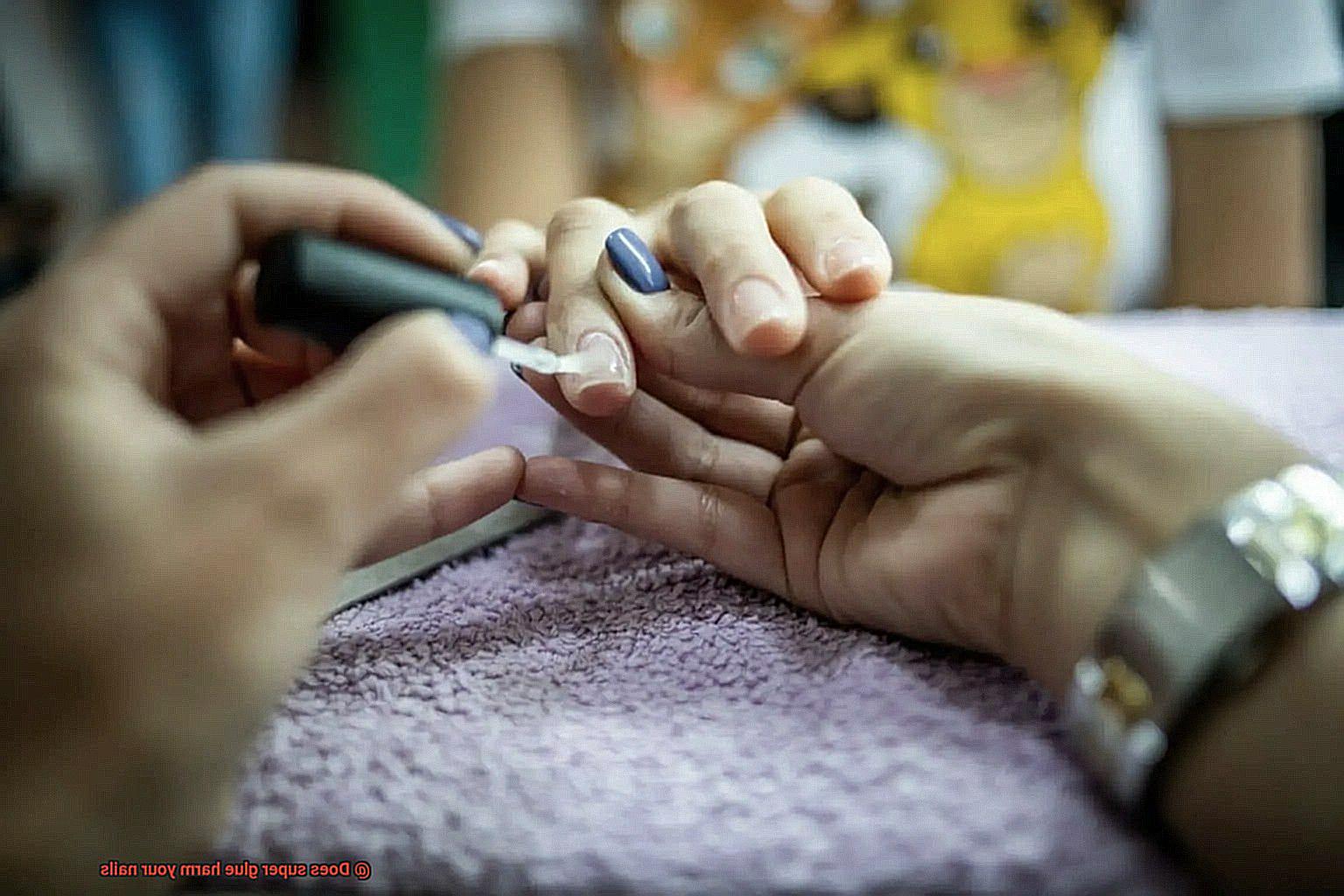
When applying super glue, precision is key. Use small amounts of glue and be careful not to get it on your cuticles or the skin surrounding your nails. The chemicals in super glue can cause irritation if they come into contact with your skin. By being meticulous in its application, you can avoid any potential harm.
Consult a Professional
If you have weak or damaged nails, it is advisable to consult with a nail professional before using super glue. They can assess the condition of your nails and provide guidance on whether it is safe for you to use super glue. They may also recommend additional precautions or alternative solutions to protect your nail health.

Remove the Glue Gently
When it comes time to remove super glue from your nails, never force or peel it off. Doing so can cause significant damage to your nails and potentially lead to pain or infection. Instead, soak your fingers in warm, soapy water for a few minutes to soften the glue. Then, gently rub it off using a soft cloth or a nail file designed for gentle buffing. This method ensures that you remove the glue without harming your nails.
Give Your Nails Time to Recover
After using super glue, it is essential to give your nails time to recover. Avoid excessive filing or buffing immediately after removing the glue, as this can weaken your nails further. Instead, moisturize your nails regularly with cuticle oil or nail strengthener to promote their health and strength. By nurturing your nails, you can minimize any potential damage caused by using super glue.
How to Remove Excess or Dried-on Super Glue from Nails
Accidentally spilling super glue on your nails can feel like a disaster, but fear not. In this comprehensive guide, we will explore five simple and effective methods to remove excess or dried-on super glue from your nails without causing any harm. Get ready to bid farewell to those glue mishaps.
Soak in Warm, Soapy Water:
Begin by filling a bowl or basin with warm water and adding a few drops of mild soap. Immerse your nails in this soothing solution for approximately 10 minutes. As the warm water works its magic, it will gently soften the glue, making it easier to remove.
Gently Peel or Scrape:
After soaking, arm yourself with a wooden cuticle stick or a soft nail file. With utmost care and precision, gently peel or scrape off the excess glue. Remember, patience is key here. Avoid using excessive force as it could potentially damage your delicate nails. Take your time and proceed with caution.
Acetone or Nail Polish Remover:
If the super glue has dried and cannot be easily peeled off, it’s time to bring out the heavy artillery – acetone or nail polish remover. Soak a cotton ball or pad in acetone and place it directly on top of the glued area. To keep it securely in place, cover it with a piece of aluminum foil. Allow the acetone to work its magic for 5-10 minutes while you relax and let it do the hard work.
Massage and Rub:
Once the acetone has worked its wonders, gently massage the cotton ball over the glued area using circular motions. The acetone will have softened the super glue, making it easier to loosen and remove. For any lingering bits of glue, employ the trusty wooden cuticle stick or soft nail file to scrape them off gently. Exercise caution and avoid excessive scraping to prevent any accidental damage to your nails.
Rinse and Moisturize:
Congratulations, you have successfully bid farewell to excess or dried-on super glue. Now it’s time to rinse your hands and nails thoroughly with warm water, ensuring that all traces of glue and acetone are washed away. Pat your hands and nails dry with a soft towel, then pamper them with a moisturizing hand cream or cuticle oil. This step will nourish and hydrate your nails, replenishing any lost moisture.
Also Read: Is Glue Bad For Your Skin?
Conclusion
Super glue can indeed harm your nails.
The strong adhesive properties of super glue can cause damage to the delicate nail bed and cuticles. It can strip away layers of the nail, leaving them weak and brittle.
Furthermore, if you accidentally get super glue on your skin around the nails, it can cause irritation and even chemical burns.

